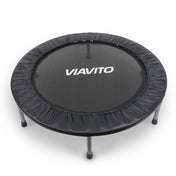What is the running deck?
The running deck is the underfoot section of the treadmill that you actually run on.
The size of the running deck is an important factor when choosing the right treadmill for your space. There are two major things to consider:
While there are other important factors to take into account, such as the power of the motor, it’s hard to think of a single more important factor than the size of the running deck when figuring out which treadmill to buy for your home. It is this that will largely determine how a treadmill will perform as a running training device and whether it’s a viable fit for where you want to put it in your home. Because of this, the running deck should be the first thing to consider.
Types of running deck: Compact, standard, and long
Running decks usually come in 2 formats: compact and standard. However, you can also get elongated decks if you’re particularly tall or have other specific needs for your treadmill.
Compact running decks exist so that you can fit treadmills into smaller spaces. These tend to be 101 - 127cm (40-50 inches) long and are specifically designed for training in tighter spaces and tend to lend themselves better to lower-intensity running than to full marathon training. They allow the use of a treadmill in spaces where a full-sized model simply isn’t an option, opening up the possibility of indoor running. However, the trade-off is that you’re shortening the maximum possible length of your stride, which is something to consider if you’re a taller person of more than 6ft with longer legs.
Standard running decks cater to most people’s needs, providing more space than most people actually need for running. The standard running deck is around 55-60 inches long or roughly 5 feet. This varies a little between models but any deck shorter than 127cm (50”) is either compact or designed for walking. Standard decks also enable most people to sprint at top speed on the treadmill thus offering up a more intensive training experience overall.
Long running decks are rare, since the standard size is almost always sufficient. These refer to anything over 152cm (5ft or 60 inches), offering a longer stride that will cater for very tall people. They’re also rare to get, more expensive (due to being tailor-made and using more materials), and take up more space in the footprint of the treadmill.
Why does running deck length matter?
For running, stride length is a factor in performance, pace, and injury-prevention. There are constant arguments about appropriate striding and how it impacts things like foot positioning, biomechanics of speed, and how it contributes to injury risk.
One thing it always comes back to is that you need to be able to stride at a comfortable length for your body.
While there’s disagreement on a lot of things in running, everyone agrees that artificially limiting your stride is an easy way to get hurt. Improper stride length because of a running deck that doesn’t suit your body can be a problem which is why standard running decks come with more length than most people need — it’s better to have too much than not enough.
Space: How much room do you need for a treadmill?
The answer depends on your space and your body. As a rule taller people need longer running decks and thus more space for their treadmill. That’s non-negotiable: you can’t run properly on a compact running deck if you’re 6’5 and all leg. It’s a recipe for injury and/or poor running technique.
Shorter people have more options as they can run on any size deck. The compact deck is entirely designed for the convenience of reducing the space-demands of a treadmill. Not every shorter person has those space problems, so a standard deck is fine for many shorter people and suits many homes’ spaces. In these instances all you need is to know the footprint of the treadmill you’re considering and measure up the space in which you intend to place it. If the space you have is larger than the footprint of the treadmill in the open and ready to use position, then it’s suitable.
The long running deck is a rarity but comes with the necessity of running at home in conditions that are healthy for your knees, hips, and spine. If you need length, you can’t compromise because the cost is your health — even if that does limit where you can put a long-deck treadmill! Just make sure you measure the space you’re planning on putting it in before it’s delivered as sending back large, heavy treadmills tends to be expensive!
Final thoughts
Treadmills are versatile pieces of equipment — and that extends down to the running deck option you choose. There are some limitations to each, if you’re short on space or need an extra-long deck. However, it’s great that there are options out there to accommodate different people and the different needs of home treadmill use.
If you’ve got the space then standard is usually the best bet. However, if you’re short on space and you don’t need a standard deck, a compact model can be a great way to make a treadmill work for your home space and get all the benefits of running in the comfort of your own home.
For more guidance, check out our buyer’s guide for treadmills here.
To take a look at our full product range, check out our store. Or for more expert exercise information, check out our features hub.
